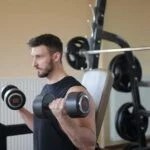Calf raise is the most effective exercise for the development of calf muscles. With the help of calf raise machine we can easily stretch the calves of the legs as much as possible at the lower point of the dimension and still shorten at the upper point.
However, it is lot more complicated than it seems at first glance. Many beginners do this exercise incorrectly, because they lift heavy weight and work at a minimum dimension, without focusing on particularly on the calf muscles for training.
So, if not done correctly you will get a maximum of 10% benefit from this exercise. If you want to get maximum results, you need to work differently. It may be hard and painful, but it will be worth it. Please read our article on how to do it the right way.
Calves are often overlooked when it comes to weight training, but they are an important part of many activities – from walking, running and jumping. Involve the standing calf in your lower-body workout to make all these actions easier.
Benefits of Calf Raise Machine.
Calf raising can be done in many forms: with dumbbells, with a barbell on the shoulders, in the Smith machine, but at best, in a special machine. All calf exercises are obtained from the classic standing toe lift.
By training your calves in a leg press machine, you’re absolutely repeating the process of raising your calves by standing in the machine. The only difference is that there is no axial load on the spine.
Benefits.
It is enough to practice calf raise once a week, for example, at the end of a leg workout. This will be enough for muscle growth.
Do not forget that the calf muscles act as stabilizers during basic exercises, such as the frontal squats with deadlifts and barbells. The stronger the stabilizer the muscles, the more weight you can lift.
Therefore, calves should be trained not only for those who want a beautiful muscular lower leg, but also for athletes who set the goal of increasing the weight of their work in basic movements. All experienced power lifters and cross fit athletes take time out in their training program to train their calves.
Muscles Engaged In Calf Raise Exercise.
90% of the dynamic load falls on the calf muscles. The remaining load is distributed among the spine, trapezius muscles, quadriceps and extenders of the buttocks.
For the full development of the lower leg muscles, you also need to train the only muscle located under the calf. To do this, it is best to sit in the machine and lift it off your toes.
When the flounder muscle is well developed, it “pushes” the calf muscles, and it takes a more peak shape. The same is the story with the posterior and middle bundles of deltoid muscles.
How To Use Calf Raise Machine?
Now almost every gym has a standing calf lifting machine. Its main benefits is that it is convenient enough to stretch the muscles at the lower point of the dimension, since there is still a sufficient distance between the floor and the platform for the legs.
Initial position for practice: At first we only stand on the platform with the toes, lowering the heels and trying to “fall” them as much as possible.
This is so that you feel the stretch in your calf muscles, making everything go right with the technique. This is our starting point and we need to bring each repetition to this point.
At the lower point, we pause for a few seconds to move the calf muscles forward. The exercise is performed in the maximum possible dimension.
Then we go up again, trying to rise as high as possible.
How long you need to hold depends on how much you can “squeeze” the calf muscles as much as possible to relieve the pain.
This is great if you can stop the maximum contraction for 3-4 seconds. After 6-8 repetitions in this mode, you feel a strong pumping sensation in the calf muscles. After another 5 minutes, you feel a sharp pain.
You must continue to work until you feel completely tired. When you can’t do maximum stretching and extreme contractions, do some more imperfect repetitions to finally load the muscles and finish the workout.
Types of Calf Raise Machine.
Seated Calf Raise Machine.
The seated calf raising machine is a form of calf variation and is an exercise used to isolate the muscles of calves.
Calves can be a stubborn muscle group for a lot of people, so it’s important to experiment with many different angles when picking up a calf. You can also consider training calves with a high training frequency.
A sitting calf can be included in your leg workout and whole-body workout.
How To Use Seated Calf Raise Machine.
- Take a seat on the machine and place the balls of your feet on the platform while keeping your toes forward – your heel will naturally hang. Place the base of the quads under the knee pad and let your hands rest upwards.
- Stretch your ankles and leave the safety bar.
- Lower the ankles by tilting it backwards until the calves are pulled completely.
- Spread the ankles and exhale as the calves bend.
- Repeat as per the prescribed number of repetitions.
Additional Tips.
- Keep the repetition slow and under control. Limit the motion and stop at the top to emphasize the contraction.
- If you feel some kind of stretch from under the foot during exercise, limit the depth of the heel.
- Try to move the ball forward with the toe instead of the base of the toes.
Standing Calf Raise Machine.
If you are interested in isolating calves, then exercise with standing calf raise machine is an excellent exercise.
Specifically, the standing calf raise machine targets the muscle of the calf gastrointestinal tract. Gastronomies is known as the “show” muscle of the calf.
How To Use Standing Calf Raise Machine.
Calf raise is a method of exercising the gastrocnemius, tibialis posterior, peroneal and soleus muscles of the lower leg. The movement that is performed is plantar flexion, aka ankle extension.
- Adjust the shoulder according to your height.
- Step under the pads and place the balls of your feet on the platform while keeping your toes straight forward – your heel will naturally hang.
- Stretch the hips and knees to lift the shoulder pads up.
- Lower the ankles by tilting it backwards until the calves are pulled completely.
- Spread the ankles and exhale as the calves bend.
- Repeat as per the prescribed number of repetitions.
Additional Tips.
- Keep the repetition slow and under control. Limit the motion and stop at the top to emphasize the contraction.
- If you feel any kind of pain or pressure in the back of the knee joint, lean slightly in the knee and avoid a complete lockout.
- If the knee is not completely locked then make sure that there is no change in position during the period of recurrence.
- If you feel some kind of stretch from under the foot during exercise, limit the depth of the heel.
- Try to move the ball forward with the toe instead of the base of the toes.
Donkey Calf Raise Machine.
Donkey raise calf is a bodyweight exercise designed to target your lower leg muscles. Do donkey calf raise by stand with your legs shoulder-wide apart.
Rest your hips and tilt your upper body forward. Push into the front of your legs, activating your calf muscles as you stand on your tiptoe. Return to a regular stance and repeat the pattern of movement.
At first, start with 2-3 sets of 10-20 repetitions. Choose your set and reps based on your ability to maintain good technique across all sets and repetitions.
How To Use Donkey Calf Raise Machine.
- Stand in front of a strong object such as a bench and adjust it to waist height.
- While holding the bench, move a few steps backwards and place your feet on an aerobic step or two large weight plates. Turn your shoulders outwards to engage your lats.
- Rest your hips backwards until your back is parallel to the floor. Pre-strain your shoulders and attach your core. Your chin should stick throughout the movement, as if you were holding an egg under your chin.
- Push the balls of your feet and should be on aerobic steps while pulling your calf muscles, keeping your heel towards the ground. All repetitions should begin with this situation.
- While maintaining your alignment, push the balls of your feet into aerobic steps and squeeze your calves to move upwards.
- Squeeze your calves towards top position and stop.
- Slowly return to the initial position. Stretching your calf muscles, let your heel move toward the floor. Complete the whole step before starting the next repetition.
+1 Source
Freaktofit has strict sourcing guidelines and relies on peer-reviewed studies, educational research institutes, and medical organizations. We avoid using tertiary references. You can learn more about how we ensure our content is accurate and up-to-date by reading our editorial policy.
- Muscle fibre type composition in the lateral muscle of olive flounder Paralichthys olivaceus; https://www.sciencedirect.com/science/article/abs/pii/S0065128118302265









































 Workout
Workout

 Meditation
Meditation






 Podcast
Podcast
 E-book
E-book














